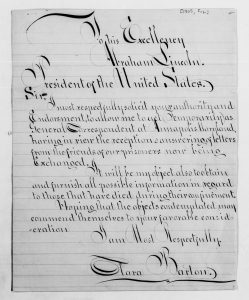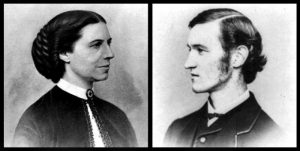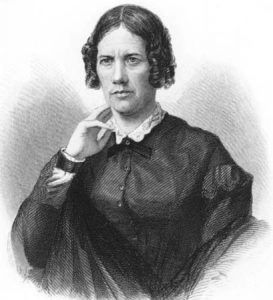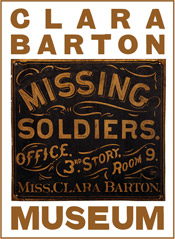Opening Clara Barton’s Missing Soldiers Office – 1865
Museum members are the reason we can bring you scholarship like this.
CONSIDER SUPPORTING THE MUSEUM TODAY
“The prospects of a speedy peace either in the conquest or the submission of the South has never been so cheering,” the New York Herald triumphantly declared on January 1, 1865. In early 1865, the Confederacy reestablished the practice of prisoner exchange.[1] As a result, thousands of emaciated and desperately ill former prisoners from infamous prisons like Andersonville and Belle Isle began arriving at a designated drop-off point known as Camp Parole, near Annapolis, Maryland.
At the beginning of 1865, Clara Barton (already a famous nurse) had returned to Washington to nurse her brother Stephen and nephew Irving Vassall who had both fallen ill. While Barton was in Washington, Vassall, a government employee, had heard news that exchanged Union prisoners were returning in poor condition and that the government needed help corresponding with relatives of those who returned and those who did not. He relayed the information to Barton in the hope that she might be able to offer assistance. She empathized deeply with families suffering loss, because she would eventually lose both Stephen and Irving in the spring of 1865.
In February 1865, Barton wrote to President Abraham Lincoln in pursuit of permission to become an official government correspondent seeking those who had vanished during the conflict. In an effort to capture the attention of a man besieged by correspondence, she wrote her letter in exceedingly grandiose script.

Barton’s letter to Lincoln, February 1865. Courtesy of the Library of Congress
To his Excellency Abraham Lincoln President of the United States
Sir, I most respectfully solicit your authority and endorsement to allow me to act temporarily as general correspondent at Annapolis Maryland, having in view the reception and answering of letters from the friends of our prisoners now being exchanged.
It will be my object also to obtain and furnish all possible information in regard to those that have died during their confinement.
On March 24, 1865, Barton received the sanction of the president to go to Annapolis, Maryland in an official capacity. Her job would be to list the names of those who died in captivity and notify their families.
At Annapolis, Barton witnessed chaos as thousands of emaciated former prisoners disembarked from the vessels that carried them to freedom from Confederate prisons. As the weakened men struggled from the ships, Barton noted that inconsistent record-keeping made it almost impossible to know who had been left behind in the graveyards at the prisons. In lieu of official reports, Barton turned to the best source of information she had on-hand: the soldiers themselves.
Word quickly spread about her appointment to look for missing soldiers through the newspapers, and already by 1865, Barton had developed a reputation as a friend of the soldier. She often traveled to battlefields to help the sick and wounded, so loved ones occasionally sent her letters inquiring if she had seen their relatives.
Barton’s official appointment meant she received thousands of letters (sometimes as many as 100 a day) from concerned relatives looking for loved ones.
Gradually she compiled a master list of soldiers who had disappeared during the Civil War. In June 1865, she published the first “Roll of Missing Men” which listed 1,533 names. By the conclusion of her work in 1867, she published five separate rolls which contained 6,650 names. These lists included thousands of names, organized by state, and contained instructions for anyone, with knowledge of these men’s whereabouts to write to her. Barton looked especially to veterans for assistance in the search.

Clara Barton and Dorence Atwater
A meeting with Dorence Atwater in June 1865 propelled her mission to new heights. Atwater kept a hidden list of those who died at the notorious Andersonville Prison during his time in captivity there. His information enabled an expedition, which included Barton, to go to Andersonville, identify the graves of 13,000 missing soldiers, and notify the families. The team eventually established a national cemetery at the location of the prison. The whole process lasted through the middle of August.

Francis Dana Barker Gage
As a part of the Andersonville team, Barton played a significant role in bringing closure to thousands of families, but she was unsure how much longer she could continue to search for missing men without extra money or help. It was not until early 1866 with the assistance of her friend Francis Dana Barker Gage that Barton was able to raise money to hire clerks to continue her work. Gage wrote several pleas for Barton in the New York Independent soliciting money for her noble cause. Gage also helped Barton draft a petition to send to Congress that ultimately granted her $15,000 to keep the mission going. With that boost, she was able to continue the work of the Missing Soldiers Office through the end of 1867.
As someone who had seen and helped to ease so much physical trauma on Civil War battlefields, Barton recognized how important the work of finding missing men was to sooth the minds of loved ones at home. Barton herself tried to describe the inspiration that kept her moving in spite of challenging circumstances in a letter to a benefactor:
If it has been my privilege to lighten never so little the heavy burden of grief which has been laid upon the hearts of our suffering people, or throw the feeble weight of my arm on the side of my country in her hour of trail, if I have made one heart stronger, or one war less bitter, I regard it as a blessing forever beyond my power to express. And whatever yet remains to be done, or however weary I may become even in well doing, my soul will always be lifted up, my hands strengthened, my step quickened, and the miles shortened by the reflection that the hearts of good men and women are with me in my work; that I carry their respect and approval, and that their generous consideration is helping me on to its accomplishment.
Endnotes
[1] The Confederacy had stopped exchanging prisoners in 1863 when the Union allowed units of African-American troops to serve. As time went by the excess of Union prisoners became a drain on Southern resources, and the Confederacy needed more men to fill its thinning ranks. They therefore resumed the practice of prisoner exchange in early 1865. Read more about it here.
About the Author
John Lustrea is a member of the Education Department at the National Museum of Civil War Medicine. He earned his Master’s degree in Public History from the University of South Carolina. Lustrea has previously worked at Harpers Ferry National Historical Park during the summers of 2013-2016.
Tags: Abraham Lincoln, Andersonville, Clara Barton, Clara Barton Missing Soldiers Office, Dorence Atwater, Francis Dana Barker Gage, Rolls of Missing Men Posted in: Uncategorized
